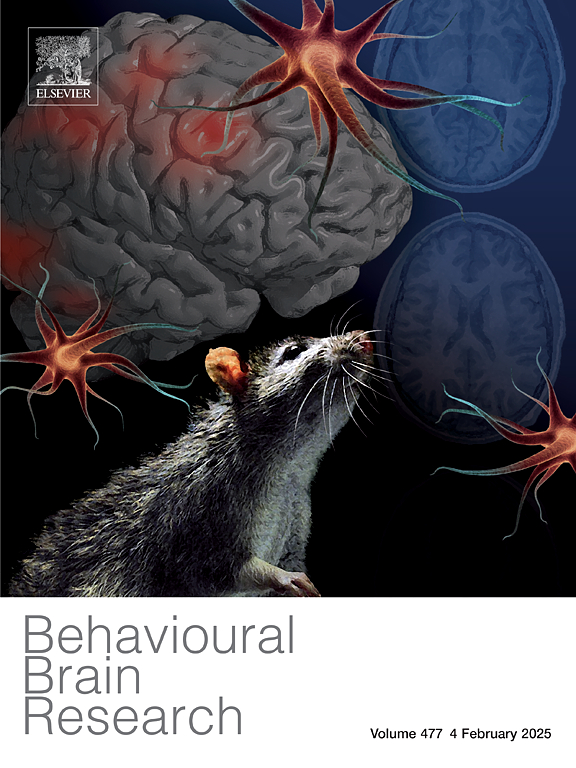4周标准与1周加速间歇性θ波爆发刺激治疗抑郁症-回顾性分析
IF 2.6
3区 心理学
Q2 BEHAVIORAL SCIENCES
引用次数: 0
摘要
间歇性θ波爆发刺激(iTBS)是一种特殊形式的重复经颅磁刺激(rTMS),越来越多地用于治疗情感性障碍。与标准方案相比,治疗时间较短的加速iTBS方案(aiTBS)可能导致相同但更快的反应率。方法回顾性分析某三级医院2023年4月至2023年9月期间66例重度抑郁症rTMS住院和门诊患者的记录。所有患者接受1200次脉冲左前额叶iTBS,或4周内每天1次(n = 34),或1周内每天5次左前额叶iTBS (n = 32)。分别在治疗前和治疗结束时用21项汉密尔顿抑郁评定量表(HAMD-21)和重度抑郁量表(MDI)评估抑郁症状。结果根据HAMD-21和MDI, iTBS和aiTBS治疗组抑郁严重程度均有显著改善。iTBS的缓解率分别为38 % (HAMD-21)和35 % (MDI), aiTBS的缓解率分别为19 % (HAMD-21)和16 % (MDI)。缓解率也表现出类似的模式。组间差异的效应量为小到中等。两组均未发生严重不良事件。aiTBS的耐受性较低。在定性和主观层面上,aiTBS的总体满意度较低。结论每日5次1200次的itbs治疗可在1周内改善症状。但与四周的iTBS相比,获益、满意度和耐受性略低。在日常临床实践中,可以在权衡后勤方面的缺点后考虑aiTBS方案,例如可能需要更长的等待时间才能开始接受经颅磁刺激治疗的新患者。未来的研究应该探索快速有效减轻症状的最佳剂量方案(每天疗程次数,每次疗程次数)。本文章由计算机程序翻译,如有差异,请以英文原文为准。
Four weeks standard vs. one week accelerated intermittent Theta Burst Stimulation for the treatment of depression – A retrospective analysis
Introduction
Intermittent Theta Burst Stimulation (iTBS), a specific form of repetitive transcranial magnetic stimulation (rTMS) is increasingly used for treating affective disorders. Accelerated iTBS protocols (aiTBS) with shorter treatment duration may lead to equal but faster response rates compared to standard protocols.
Methods
Here, we retrospectively analyzed the records of 66 rTMS in- and out-patients with major depressive disorder in a tertiary care hospital between April 2023 and September 2023. All patients received left prefrontal iTBS with 1200 pulses, either one session/workday over 4 weeks (n = 34) or left prefrontal aiTBS on five sessions/workday for one week (n = 32). Depressive symptoms were assessed with the 21-item Hamilton Depression Rating Scale (HAMD-21) and the Major Depression Inventory (MDI) before and at the end of the respective treatment.
Results
With both treatments, iTBS and aiTBS, the severity of depression improved significantly according to HAMD-21 and MDI. Response rates for iTBS were 38 % (HAMD-21) and 35 % (MDI), for aiTBS 19 % (HAMD-21) and 16 % (MDI), respectively. Remission rates showed a similar pattern. Effect sizes for group differences were small to medium. No serious adverse events occurred in any group. Tolerability was lower in aiTBS. Overall satisfaction was low for aiTBS on a qualitative and subjective level.
Conclusion
aiTBS with 1200 pulses and five daily sessions lead to amelioration of symptoms within one week. But benefit, satisfaction, tolerability was slightly lower in contrast to four weeks of iTBS. For everyday clinical practice, aiTBS protocols can be considered after weighing up the logistical disadvantages, such as possible longer waiting time for new patients that want to start a therapy with TMS. Future studies should explore the optimal dosage regime (number of sessions per day, number of pulses per session) for fast and effective symptom reduction.
求助全文
通过发布文献求助,成功后即可免费获取论文全文。
去求助
来源期刊

Behavioural Brain Research
医学-行为科学
CiteScore
5.60
自引率
0.00%
发文量
383
审稿时长
61 days
期刊介绍:
Behavioural Brain Research is an international, interdisciplinary journal dedicated to the publication of articles in the field of behavioural neuroscience, broadly defined. Contributions from the entire range of disciplines that comprise the neurosciences, behavioural sciences or cognitive sciences are appropriate, as long as the goal is to delineate the neural mechanisms underlying behaviour. Thus, studies may range from neurophysiological, neuroanatomical, neurochemical or neuropharmacological analysis of brain-behaviour relations, including the use of molecular genetic or behavioural genetic approaches, to studies that involve the use of brain imaging techniques, to neuroethological studies. Reports of original research, of major methodological advances, or of novel conceptual approaches are all encouraged. The journal will also consider critical reviews on selected topics.
 求助内容:
求助内容: 应助结果提醒方式:
应助结果提醒方式:


